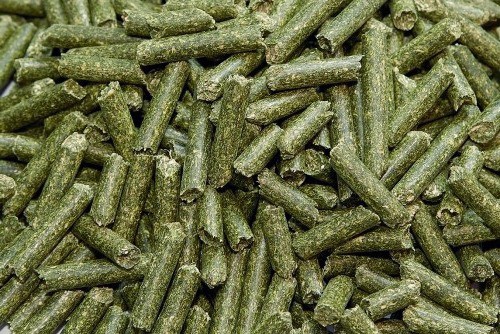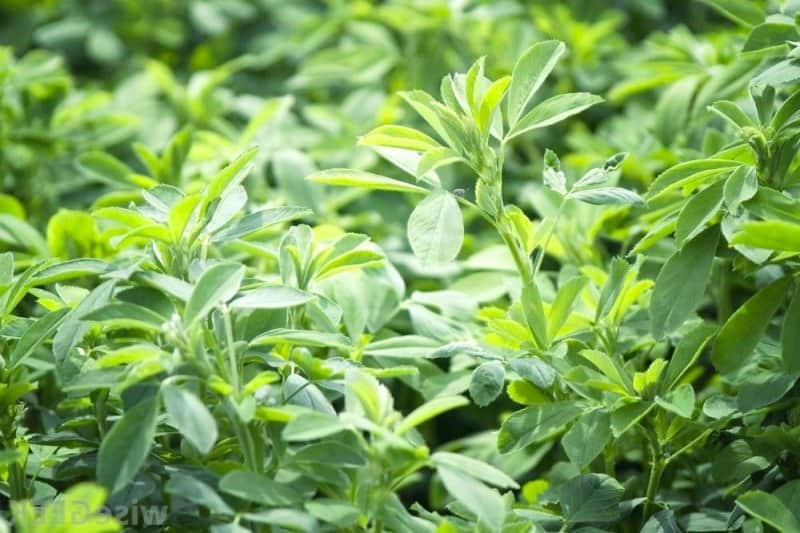by Dorothy E. Guild
A surprise had come with our regional newsletter when a member wrote that on the advice of a rose grower friend he had used alfalfa pellets on his iris with good results. It was noted that it can be used either as a side dressing or a tea to spray on the foliage. Very shortly I was off to the store to buy a bag of alfalfa pellets.
The usual commercial fertilizer mix had been spread in early April. In May the pellets went on as a side dressing for the one, two and three year old seedlings while a thin layer as a top dressing went on all seed rows. As the seedlings erupted through it they were carefully monitored so as not to be smothered.
Another application of commercial fertilizer went on after bloom. Three weeks later an “alfalfa tea” was applied with a sprinkling can down the rows. I felt that in my opinion that the iris growth was much better from the alfalfa applications. Intrigued, I had written of this to another iris friend.
Shortly thereafter he read in a garden catalogue of alfalfa use by rose growers. Included in the article was a specific analysis reporting the nutrients available in alfalfa.
In 1990 he made up three beds to take transplanted iris. He chose to try an experiment by applying alfalfa to just one of them. By late fall he saw that vigor (side fan development, plant color and growth which are very important to a commercial grower and hybridizer) had exceeded that of those not getting the alfalfa treatment.

Weatherwise here, it had looked to be a sad year for iris culture. In the past two years leaf spot had suddenly exploded and with June so cold and wet, I had expected another year of the same. It did not happen though!
Like my friend, I could not help observing how well the iris had done… seeming to exceed the performance of previous years. We will continue this experiment for three to five years and report back further results. The question is: Were our improved iris conditions attributable to the use of alfalfa? Can alfalfa pellets be a “magic carpet” for better iris culture?…
Dorothy Guild resides in Spokane, Washington. This article/item originally appeared in the CIS Newsletter April 1994 issue.
Feeding Iris alfalfa pellets
by Terry Varner
In mid-spring of 1991, upon information received earlier from an iris correspondent I began using alfalfa pellets as a side dressing in my iris beds. I had been informed that definite results were apparent within a few weeks.
Through the years I have tried whenever possible to use organic methods of cultivation in my iris beds as well as my vegetable gardens. Though I have always used commercial fertilizers on my beds along with gypsum, I have also used compost as well. Therefore the idea of alfalfa pellets was highly appealing.
Following bloom season I used the pellets on new seedlings and before long their value was evident. I had healthier seedlings than ever before. Their color was a rich, dark green. In 1990 I redid three large iris beds in my back yard. (all the same size)
At the time I added sand to loosen the clay and each one received the same amount of commercial fertilizer 12-12-12 mix, gypsum, and compost.
This spring I did not fertilize the beds. In mid June, following the bloom season I decided to experiment on these beds since each had previously been reconstructed with equal amendments at the same time. I coated one bed heavily with alfalfa pellets and left the other two beds without alfalfa pellets or any other fertilizers.

By summers end there was a very noticeable difference in the color, growth and development of the bed receiving the alfalfa pellets. The growth side rhizomes appeared on the irises in the treated beds two to three weeks before they did in the untreated beds.
My seedlings which had been treated shortly after being transplanted also had tremendous side growth with some having as many as 6-8 side fans by fall.
In my beds I coated the ground heavily with the pellets and applied them on a wet soil so that they would begin to draw moisture and disintegrate. I doubt that you can use them too heavily on iris. They do not burn. An interesting side observation is that I had practically no leaf spot this year.
While it was a dry summer, by August we began to have good rains. I will not claim that the pellets themselves reduced the problem of leaf spot but it was nil this year except in the untreated beds.
Excited by what I was experiencing from using alfalfa pellets I began to research their composition. What do alfalfa pellets contain that would be of value in iris beds? The following information from Nitron Industries Inc., Fayetteville, Arkansas might help us to understand.
Alfalfa has many qualities in the nutrition area, not only for plant use, but for soil organisms as well. One very important ingredient is Triacontanol, a powerful plant growth regulator. Orchid and rose growers make an alfalfa tea and spray it directly on as a foliar nutrient.
Other benefits of alfalfa: very high in vitamin A plus Thiamine, Riboflavin, Pantothenic Acid, Niacin, Pyridoxine, Choline, Proline, Bentaine, Folic Acid, plus N-P-K-Ca, Mg and other valuable minerals, also included are the sugars and starches, proteins, fibre, plus co-enzymes and 16 amino acids. How could your soil not respond to such a delicious meal? We recommend a handful per plant or sprinkle lightly down the row.
Alfalfa meal or pellets are excellent to add to your compost pile. Make a tea and spray the liquid as a foliar feed while adding the remaining wet alfalfa to the soil. Fifty pounds of alfalfa meal or pellets will feed 1,000-2,000 square feet.
Alfalfa Tea; Fill a five gallon bucket with water, add two pounds of alfalfa pellets/meal. Let sit overnight. The result will be a thick tea. Use as explained above. If you have not tried using alfalfa pellets why not try them this year? We believe that you will like the results.
Terry Varner resides in Marietta, Ohio and this article originally appeared in The Medianite Volume 33 #2 1992. This article/item also appeared in the CIS Newsletter April 1994 issue. It has been edited slightly.
More on Alfalfa – Some Comments
by Terry Aitken

We replant our iris back into the same ground every year and we are careful to add humus each year, as a reconditioner and Nemacur (a soil insecticide) to control nematodes. The most cost effective product that we have found is alfalfa pellets which we apply at about one ton per acre (or one 50 lb bag per 100 feet of row).
It is applied in late August as our shipping season winds down and about two weeks before transplant begins. The fields are stripped and a tractor grinds everything in, both alfalfa and Nemacur, in one step. Presto we are ready to plant back!
We first saw alfalfa used by Elmer Price, a fine iris grower in Tacoma, Washington. I think that he used a higher concentration than we do and his results were impressive.
George Shoop used the “tea method” and also got good results. We have been pellet spreaders for about seven years. We particularly like the idea that the alfalfa usage helps the plants to get re-established before the ground cools for the winter.
Terry Aitken is a hybridizer and iris grower in Vancouver, Washington. This article/item originally appeared in the CIS Newsletter July 1994 issue.
The use of alfalfa pellets sure sounds like something extremely interesting and beneficial to try on our own garden irises. If you try this, we would really like to hear of your experiences and/or results.


 Hello everyone! We are a society of iris lovers. Growing different kinds of irises – is our all-time favorite hobby. In our blog, you find detailed information about iris flower cultivation and fertilization. We will show you that gardening can be interesting and fun!
Hello everyone! We are a society of iris lovers. Growing different kinds of irises – is our all-time favorite hobby. In our blog, you find detailed information about iris flower cultivation and fertilization. We will show you that gardening can be interesting and fun!